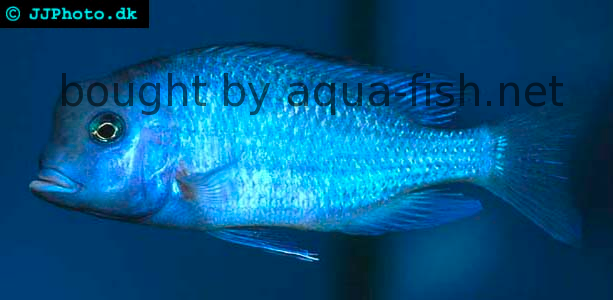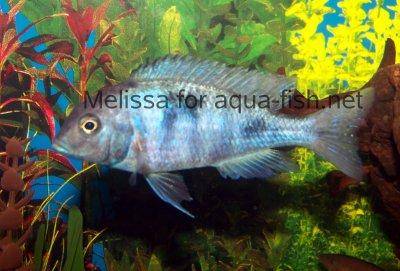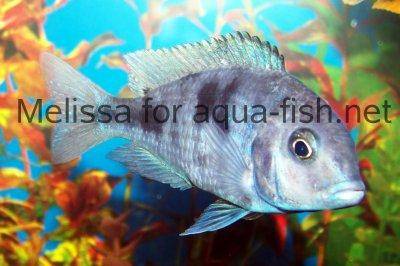Comprehensive Care Guide for Blue Dolphin Cichlids (Cyrtocara moorii)
Quick links - Answers
Brief Description
This article provides comprehensive care instructions for the stunning Blue Dolphin Cichlids, also known as Cyrtocara moorii. From tank setup and dietary needs to breeding and compatibility, this guide covers everything you need to know to keep these fish thriving in your home aquarium. For quick access to a summarized profile, be sure to check the Malawi Blue Dolphin Profile as well.
Scientific and Common Names
The Blue Dolphin Cichlid is scientifically recognized as Cyrtocara moorii but was previously classified under the genus Haplochromis. Its distinctive appearance, with a protruding forehead resembling that of a dolphin, inspired its common name. Additional names for this species include Malawi Blue Dolphin, Dolphin Cichlid, Blue Moorii, and Hap Moorii. This species is widely admired for its vibrant blue coloration and relatively peaceful nature among cichlids.
Appearance and Unique Features
The most notable characteristic of the Blue Dolphin Cichlid is its large nuchal hump, which begins to form as the fish matures and continues to grow with age. Both males and females develop this hump, although it tends to be more pronounced in males. Their bodies are a brilliant metallic blue, with some individuals displaying black markings. They can grow up to 10 inches (25 cm) in length, although females are typically smaller. Their lifespan ranges from 12 to 15 years when given proper care. Despite their size, they grow relatively slowly, only reaching sexual maturity after several years.
Behavior and Tank Mates
Blue Dolphin Cichlids are generally peaceful compared to other African cichlids, but they can still show aggression, especially during breeding or in crowded environments. As carnivores, they may prey on smaller tank mates, so it’s crucial to avoid keeping them with small fish like tetras or guppies. They do best with other moderately aggressive cichlids and larger species such as plecos, Synodontis catfish, or Corydoras.
For Corydoras catfish, it’s important to provide an environment with plenty of plants, as these peaceful bottom-dwellers feel more secure when they have hiding places. Corydoras should be kept in groups of at least six to mimic their natural schooling behavior and reduce stress. When keeping Corydoras with Blue Dolphin Cichlids, opt for larger species such as Bronze Corydoras or Albertini corydoras, as smaller Corydoras may be at risk of being eaten due to their size.
Blue Dolphin Cichlids thrive in species-specific tanks or mixed cichlid setups, provided there is enough space. Ensure multiple hiding places and open swimming areas to reduce territorial disputes. It’s advisable to maintain a male-to-female ratio of 1:3, as this prevents males from becoming overly aggressive during breeding.


Feeding and Dietary Requirements
Blue Dolphins are micro-predators, which means they primarily feed on small organisms disturbed by substrate-digging fish in their natural habitat. In captivity, they require a high-protein diet consisting of live or frozen foods such as bloodworms, brine shrimp, and krill. High-quality cichlid pellets and flakes should form the staple of their diet. Occasional offerings of beef heart, mysis shrimp, or other meaty foods can enhance their growth and coloration.
Although they prefer protein-rich meals, it’s essential to provide variety. Offer foods like frozen daphnia and frozen plankton to introduce nutritional diversity. Avoid overfeeding fatty foods like beef heart, which can cause digestive issues if fed too often. Their diet can be supplemented with vegetable matter, but this is not a significant requirement. A healthy, varied diet will promote growth and longevity, as well as maintaining vibrant coloration.
Natural Habitat and Origin
Blue Dolphin Cichlids are endemic to Lake Malawi in East Africa, one of the world’s largest and most biodiverse lakes. This species inhabits sandy, open areas of the lake, avoiding rocky zones where mbuna cichlids are more common. The unique ecosystem of Lake Malawi is characterized by hard, alkaline water, which should be replicated in captivity to ensure optimal health.
Water Parameters and Tank Setup
Maintaining stable water conditions is crucial for Blue Dolphins, as they thrive in hard, alkaline water with a pH between 7.2 and 8.6. The water hardness should range from 10 to 20°N dGH (~178 - 357 ppm). Aim to keep the temperature between 74°F and 81°F (23°C to 27°C). Their natural environment is rich in oxygen and features clear, flowing water, so using a strong filtration system that provides good water movement is recommended.
Given their size and active nature, Blue Dolphins require a spacious tank. A minimum of 125 gallons (~473 liters) is ideal for a small group, ensuring they have enough room to establish territories and prevent aggression. A sandy substrate is preferred, as this mimics their natural habitat. Rocks can be used sparingly to create hiding spots, but open swimming space is more important for this species.
Ensure the aquarium has sufficient aeration and water movement, as Blue Dolphins thrive in oxygen-rich environments. A high-capacity external filter is recommended, along with powerheads or airstones to maintain the water flow and oxygenation. Regular water changes of 20-30% every week will help keep nitrate levels low, which is especially important for encouraging breeding behavior.
Sexing Blue Dolphin Cichlids
Unlike many other cichlid species, both male and female Blue Dolphin Cichlids develop a nuchal hump. As a result, sexing them can be challenging. Males are typically larger than females and may display slightly brighter colors during spawning, but these differences are subtle. It’s recommended to keep multiple individuals and observe their behavior to determine their sex. Males may become more dominant and display courtship behavior when ready to breed.
In addition to physical size, males may exhibit increased territorial behavior, especially in the presence of females. Subtle changes in coloration, including darkening of the blue hue, may indicate a male preparing to breed. Females, in contrast, will generally be smaller and exhibit less territorial behavior.
Breeding and Raising Fry
Although challenging, it is possible to breed Blue Dolphin Cichlids in captivity. Frequent water changes, a high-protein diet, and a well-maintained tank with multiple females for one male increase the chances of successful spawning. The male will display courtship behavior by extending his fins and exhibiting brighter colors to attract a female.
Blue Dolphins are maternal mouthbrooders, meaning the female carries the eggs in her mouth until they hatch. A typical brood consists of 20 to 90 eggs, which are fertilized by the male before the female collects them. The incubation period lasts around 3 to 4 weeks, during which the female will not eat. Once the fry are released, they can be fed micro worms, baby brine shrimp, or finely crushed flakes. It's recommended to move the female to a separate tank during the brooding period to protect the fry from predation.
During the holding period, it’s important to provide a stress-free environment for the female. If moved to a separate tank, ensure that water parameters are identical to the main tank to avoid shocking the female. Once the fry are released, they can be raised in the separate tank until they are large enough to be safely reintroduced to the community.
Pictures
Sources
- animal-world.com
- gcca.net
- aquariumlife.net
- Aquarium Fishes of the World by Dr. Herbert R. Axelrod, Dr. Warren E. Burgess, Neal Pronek, Glen S. Axelrod, David E. Boruchowitz


